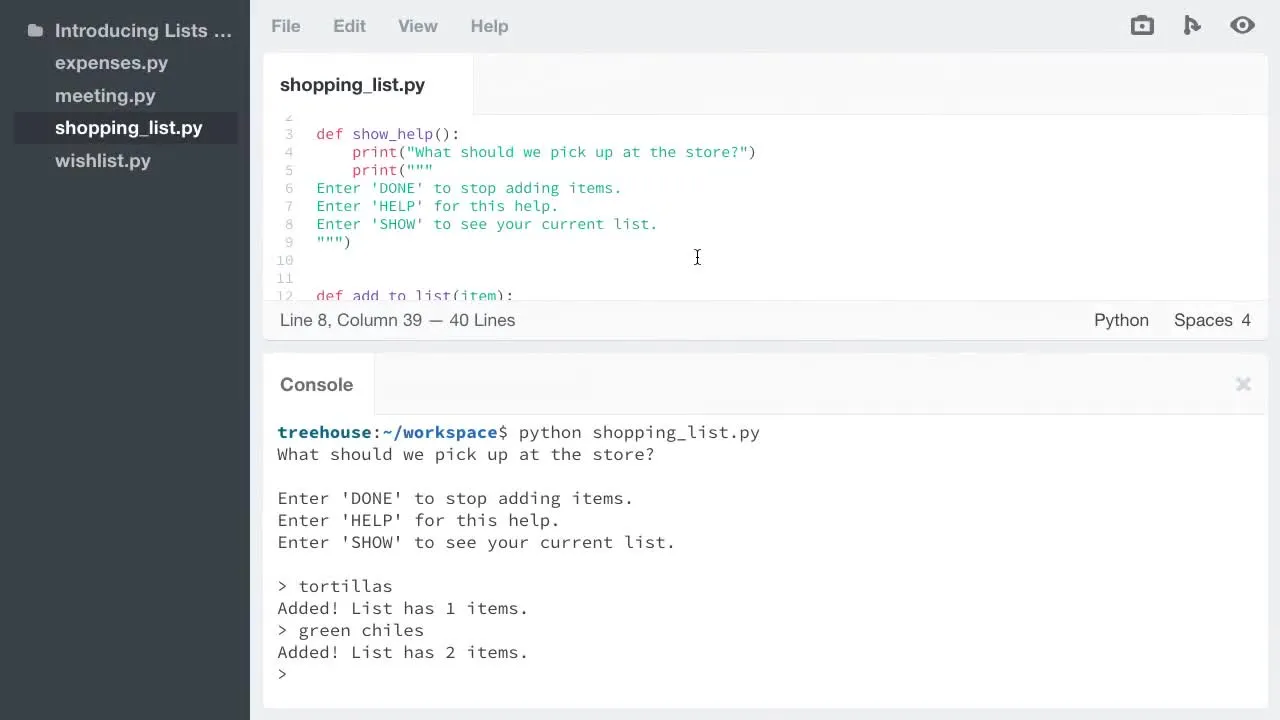
Introducing Lists Course 
This course introduces students to the powerful data type of lists. Students will learn common use cases, as well as how to manipulate lists through appending, extending, concatenating, and more. With this knowledge, students will be able to use lists to store multiple ordered values in a single container. ▼
ADVERTISEMENT
Course Feature
![]() Cost:
Cost:
Free Trial
![]() Provider:
Provider:
Treehouse
![]() Certificate:
Certificate:
No Information
![]() Language:
Language:
English
![]() Start Date:
Start Date:
On-Demand
Course Overview
❗The content presented here is sourced directly from Treehouse platform. For comprehensive course details, including enrollment information, simply click on the 'Go to class' link on our website.
Updated in [March 06th, 2023]
This Introducing Lists Course provides an overview of the powerful data type of lists. Students will learn common use cases of lists, how to manipulate lists by appending, extending, concatenating, and removing, how to iterate values, and how to use multidimensionality. By the end of the course, students will have a better understanding of how to use lists in their own projects.
[Applications]
After completing this course, students can apply their knowledge of lists to a variety of tasks. They can use lists to store and manipulate data, such as creating a shopping list or a to-do list. They can also use lists to iterate through values, such as looping through a list of numbers or strings. Additionally, students can use lists to create multidimensional data structures, such as a list of lists.
[Career Paths]
1. Data Scientist: Data Scientists use lists to store and analyze large amounts of data. They use lists to create models and algorithms to make predictions and draw insights from data. As data science continues to grow, the demand for data scientists with a strong understanding of lists will continue to increase.
2. Software Developer: Software Developers use lists to store and manipulate data in applications. They use lists to create efficient and effective code that can be used to build applications. As software development continues to evolve, the need for developers with a strong understanding of lists will continue to grow.
3. Database Administrator: Database Administrators use lists to store and manage data in databases. They use lists to create efficient and effective queries that can be used to retrieve data from databases. As databases become more complex, the need for database administrators with a strong understanding of lists will continue to increase.
4. Data Analyst: Data Analysts use lists to store and analyze data. They use lists to create models and algorithms to make predictions and draw insights from data. As data analysis continues to grow, the demand for data analysts with a strong understanding of lists will continue to increase.
[Education Paths]
1. Computer Science Degree: A computer science degree is a great way to learn the fundamentals of programming and software development. This degree path will provide learners with the skills to develop software applications, create algorithms, and understand the principles of computer science. Additionally, this degree path is becoming increasingly popular due to the growing demand for software developers and the need for more advanced technology.
2. Data Science Degree: Data science is a rapidly growing field that combines mathematics, statistics, and computer science to analyze and interpret large datasets. This degree path will provide learners with the skills to analyze data, develop predictive models, and create visualizations. Additionally, this degree path is becoming increasingly popular due to the growing demand for data scientists and the need for more advanced data analysis.
3. Artificial Intelligence Degree: Artificial intelligence is a rapidly growing field that combines computer science, mathematics, and statistics to create intelligent systems. This degree path will provide learners with the skills to develop algorithms, create machine learning models, and understand the principles of artificial intelligence. Additionally, this degree path is becoming increasingly popular due to the growing demand for AI engineers and the need for more advanced AI applications.
4. Cybersecurity Degree: Cybersecurity is a rapidly growing field that combines computer science, mathematics, and information security to protect networks and systems from malicious attacks. This degree path will provide learners with the skills to develop secure systems, create secure networks, and understand the principles of cybersecurity. Additionally, this degree path is becoming increasingly popular due to the growing demand for cybersecurity professionals and the need for more advanced security measures.
Course Provider

Provider Treehouse's Stats at AZClass
The Introducing Lists Course introduces students to the powerful data type of lists. Students will learn common use cases and how to manipulate lists by appending, extending, concatenating, and more. The first area of learning value that learners can derive from this course is the ability to understand common use cases for lists. This lesson will give learners a broad overview of the various ways lists can be used, such as storing multiple ordered values in a single container. Learners will learn about different types of lists and how to use them in different contexts.
Discussion and Reviews
0.0 (Based on 0 reviews)
Explore Similar Online Courses

Complete Guide to Local SEO & Keyword Research

Minimalist Graphic Design for Big Ideas

RDBMS PostgreSQL

Intro To PostgreSQL Databases With PgAdmin For Beginners

PostgreSQL: Client Applications

Mastering SQL using Postgresql

Database Design and Basic SQL in PostgreSQL

PostgreSQL: Advanced Queries

Spatial SQL with Postgres : A language for geographers

Learn SQL Using PostgreSQL: From Zero to Hero

PostgreSQL Essential Training


Start your review of Introducing Lists Course